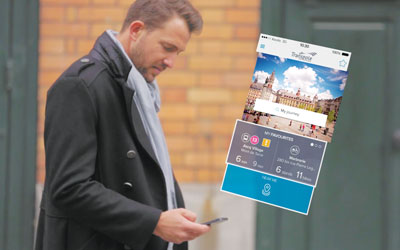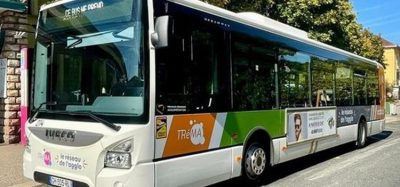The mobile revolution in public transport
- Like
- Digg
- Del
- Tumblr
- VKontakte
- Buffer
- Love This
- Odnoklassniki
- Meneame
- Blogger
- Amazon
- Yahoo Mail
- Gmail
- AOL
- Newsvine
- HackerNews
- Evernote
- MySpace
- Mail.ru
- Viadeo
- Line
- Comments
- Yummly
- SMS
- Viber
- Telegram
- Subscribe
- Skype
- Facebook Messenger
- Kakao
- LiveJournal
- Yammer
- Edgar
- Fintel
- Mix
- Instapaper
- Copy Link
Posted: 2 November 2015 | Laurent Kocher, Keolis Group’s Executive Vice President – Marketing, Innovation and Services
For Intelligent Transport, Laurent Kocher, Keolis Group’s Executive Vice President – Marketing, Innovation and Services, discusses the impact of mobile and digital technologies on public transport and how to leverage these innovations to improve the customer experience.


For the past decade, new information and communication technologies have profoundly impacted travellers’ mobility habits. Today, smart-phones are expanding their reach in both the number of users and mobile capabilities. Digital, and now mobile technology, have successively disrupted industries and successful business models. These changes took time to reach the transportation industry, but the shift in the marketplace is happening now. At the same time, the ability to gather transit mobility data from smartphones and push information back to users is changing everything from operations to the commuter journey experience. Mobile technology is also at the origin of a new transportation ecosystem of creative players, from information technology companies to ridesharing players and application creators.
Transport evolution and diversification The recent rise in investment and development of multimodal municipalities has triggered far-reaching changes. First, it has spurred the development of a wealth of transport options (bus, metro, tram, etc.), service frequency and network coverage. It has also brought back other modes, such as walking, cycling (including public bike services) and driving (carpooling, car sharing and private transportation services). Paradoxically, while today’s travellers have a wide range of transport options, it is becoming more complex for them to choose an option that best meets their travel needs.
In addition to this quickly evolving transport landscape, the digital revolution is already changing how people use public transport. According to Forrester research, smartphone ownership rates increased 7% in 2014. This massive expansion and its ensuing uses have cascaded into transport. Along with this skyrocketing use of smartphones and expanding 3G, 4G and Wi-Fi networks, we are entering the ‘Information Everywhere’ realm. This creates a new relationship between the public transport authority, the transport operator and the traveller, as well as new consumption and travel patterns. Access to travel information is becoming essential at every point in the customer journey – before, during and after. The notion of information everywhere encompasses access to the full range of transport options, anytime and anywhere the customer may be. It also means simplifying the distribution of all types of tickets across all modes of transport and all brands of smartphones.
Digital technology is becoming a lever to integrate, aggregate and facilitate multimodality. The goal is to offer travellers a streamlined experience that includes access to a full range of options (single or combined modes of transportation), merge them into a single solution and personalise this based on knowledge of the customer.
Digital trends in transportation
The current push in digital innovation is re-shaping transport and six significant trends are changing the face of public transportation today.
1. Real-time information everywhere
The arrival of ‘real-time information everywhere’ is directly linked to public transportation usages:
- 65% of smartphone owners use it during their daily commute1
- 23% of them use it to manage their trips1
- To meet the professional and private needs of their passengers, Wi-Fi transportation equipment will become a standard.
These trends are a great opportunity to make the existing transportation network more efficient, reactive and user-friendly. However, it also makes passenger’s routes more varied across modes. This causes the customer relationship management to become more complex for transportation operators.
2. Smart infrastructure
Smart infrastructure and connected transportation networks are becoming commonplace. It is one of the key pieces of analytics for real-time traffic management and incident response. Data from mobile technology is at the heart of transportation. Big data analysis helps planners and operators optimise the performance of the network, the services and the customer relationship knowledge and management.
3. User centric transportation services
With real-time information and mobile geo-location, passengers have a very high expectation of adaptation and personalisation: they are the centre of the trip.
Thus, new mobile apps are allowing commuters to compare the time, cost, convenience, carbon footprint and health benefits across all modes of transport. This broadens the range of choices for customers and allows them to make decisions on-the-fly. The apps take into account users’ needs, priorities and real-time conditions. Finally, transportation apps have to tell you what the best option right now is. Transportation is no more simply one mode that moves a passenger from A to B. It has to be a system connecting modes, services, technologies and designs according to the best option for passengers.
4. New sharing and community system
With social networks available on our smartphones, the growth of real-time listening and dialogue puts the sharing and community system at the heart of daily trips. In fact, 13% of smartphone owners1 consult social networks while commuting. There are several consecutive impacts, including:
- Changes in the customer relationship with passengers
- Passengers are both consumers and producers of travel information
- Sharing systems are replacing ownership systems creating new transportation modes such as car-sharing.
5. New transport models
Sharing rides, bikes, and cars and other business models are spreading, built on the recognition that empty car seats and empty vehicles form a ‘wasted asset’. At the same time, there is a strong diversification of public transport modes and a strong fluctuation of usages – public transportation, taxis, VTC, self-service or car-sharing. All these new transport models are made possible by mobile phones, apps, and mobile technology.
6. Emergence of a digital & integrated multimodal platform
With so much added complexity to the transport system, it is necessary to simplify how the options are presented to the traveller. Therefore, the emergence of a multimodal digital integrator is critical and should cover the whole passenger journey regardless of:
- The mode of transport
- The time of day
- Method of buying the m-ticket
- Validation requirements.
These six trends are ushering in a new mobile age in transport. The transport industry is experiencing disruption and transformation because of digital and mobile technology. Operators, such as Keolis, are anticipating and adapting to these changes to improve public transport for public transport authorities and travellers.
Innovation in the digital age of transportation
Keolis’ answer to this new digital age takes into account two key issues: increasing travel flows and the overriding goal of easing traffic congestion in cities by shifting to modality. Keolis’ mobility management platform leverages three key service solutions: plan, book and ticket:
- Plan: find the right route thanks to a multimodal and real-time trip planning
- Book: book on-line and quickly receive your itinerary and your ticket
- M-ticket: host your ticket or your monthly pass on your smartphone.
Plan-Book-Ticket is a unique, fully integrated mobile app that gives users easy access to these three key features.
Adaptable
The integrated Plan, Book, Ticket app is bundled into a white label, multi-device solution adapted to the geography. White labels make it possible to deliver specific, customised applications to cities tailored to local brands and transport solutions.
Accessible
Plan, Book, Ticket as a platform integrates APIs (for smartphones, tablets, desktops, etc.), features (itinerary searches, traffic information, etc.) and services that can accommodate third-party applications (partners, etc.) that travellers use.
Travellers are not necessarily familiar with the network brand. So the network brand alone is not enough to provide access to the full range of transport options for all traveller profiles (tourists, travelling businesspeople, etc.).
Plan, Book, Ticket access is also provided via other websites and mobile applications that occasional travellers use. For example, a businessperson from out of town could access the Public Transport API from a website or a train or plane application. The tourist could access Plan, Book, Ticket from the tourism office website or application, for example, or by going on general tourist applications (e.g. Time Out) or partner applications (travel agents).
Open
The API platform is available on request from the public transport authority in Open Services to enhance Open Data policy.
The goal is to facilitate access to these solutions and their use by opening up new applications and innovations created under open-data protocols to the community, in particular to the developer community.
The Keolis Mobility Management as a platform solution in a nutshell
Via its Plan, Book, Ticket integrated platform, Keolis provides the following:
- An open platform interfacing with several devices: Apple or Android smartphones, smart watches, TVs and interactive terminals, connected garments, etc.
- A platform packed with features, including:
- Itineraries
- Timetables
- Nearby points of interest
- Traffic information updates
- Seamless services on connected objects
- A service platform: CRM, open API, Customer Assistance, tailored to city policy
- These services are available a la carte and can accommodate all types of customers (locals and other people who know the network and brand, occasional travellers and/or visitors who do not know the brand, national and international tourists) and integrate all types of routes directly fed through city-run applications or embedded in third-party applications (tourism, travel, recreation, etc.).
With the Plan, Book, Ticket app, Keolis has created the first integrated digital solution that supports clients at each step of their journey from planning to ticket purchasing and validation, all along the route that is just right for them.
Reference
- Data sourced from Institut français d’opinion publique (IFOP)
Biography
A graduate of the Ecole Polytechnique, Laurent Kocher, began his career in 1989 at IBM France as a Sales Engineer for major clients in the public and health sectors. He also participated in the creation of the IBM Global Services division in Western Europe. He was then appointed Director of Operations of the Business Consulting and Systems Integration division before becoming Head of the Business Unit for Hosting and Transactional Solutions. In 2004, Laurent was Head of the Banking and Insurance sectors within IBM Global Services.
In March 2005, he joined the France Telecom Group to develop service activities for major French and International Companies. In 2009, he was named CIO of the France Telecom Group. Laurent joined Orange France in 2010 as Senior Vice President for SoHo, SMEs and Entreprises markets. From October 2011 to May 2013, he was CEO for France at the Atos Group. In January 2014, Laurent was appointed Executive Vice President for Marketing, Innovation and Services at Keolis.
Related topics
Passenger Experience, Ticketing & Payments, Travel & Passenger Information
Issue
Issue 5 2015
Related organisations
Keolis Group
Related people
Laurent Kocher








